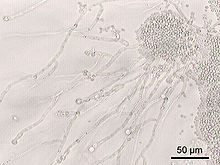
Back مبيضة (فطر) Arabic مبيضه ARZ Candida Catalan Candida CEB Candida (rod) Czech Candida (slægt) Danish Candida (Pilze) German Candida (genro) Esperanto Candida Spanish Candida Estonian
This article is missing information about list of teleomorph genera e.g. Kluyveromyces; consider PMID 26526658 & PMID 33028600. (February 2022) |
| Candida | |
|---|---|

| |
| Candida albicans at 200× magnification | |
| Scientific classification | |
| Domain: | Eukaryota |
| Kingdom: | Fungi |
| Division: | Ascomycota |
| Class: | Saccharomycetes |
| Order: | Saccharomycetales |
| Family: | Saccharomycetaceae |
| Genus: | Candida Berkh. (1923) |
| Type species | |
| Candida vulgaris Berkh. (1923)
| |
Candida is a genus of yeasts. It is the most common cause of fungal infections worldwide and the largest genus of medically important yeasts.[1][2]
The genus Candida encompasses about 200 species.[2] Many species are harmless commensals or endosymbionts of hosts including humans. When mucosal barriers are disrupted or the immune system is compromised, however, they can invade and cause disease, known as an opportunistic infection.[3] Candida is located on most mucosal surfaces and mainly the gastrointestinal tract, along with the skin.[3] Candida albicans is one of the most commonly isolated species and can cause infections (candidiasis or thrush) in humans and other animals. In winemaking, some species of Candida can potentially spoil wines.[4]
Many species are found in gut flora, including C. albicans in mammalian hosts, whereas others live as endosymbionts in insects.[5][6][7] Systemic infections of the bloodstream and major organs (candidemia or invasive candidiasis), particularly in patients with an impaired immune system (immunocompromised), affect over 90,000 people a year in the US.[8]
The genome of several Candida species has been sequenced.[8]
Antibiotics promote yeast (fungal) infections, including gastrointestinal (GI) Candida overgrowth and penetration of the GI mucosa.[9] While women are more susceptible to genital yeast infections, men can also be infected. Certain factors, such as prolonged antibiotic use, increase the risk for both men and women. People with diabetes or the immunocompromised, such as those infected with HIV, are more susceptible to yeast infections.[10][11]
Candida antarctica and Candida rugosa are a source of industrially important lipases, while Candida krusei is prominently used to ferment cacao during chocolate production. Lipases from Candida rugosa are also used to digest fats in laboratory assays because of their broad range of activity.[12]
- ^ Manolakaki, D.; Velmahos, G.; Kourkoumpetis, T.; Chang, Y.; Alam, H. B.; De Moya, M. M.; Mylonakis, E. (2010). "Candida infection and colonization among trauma patients". Virulence. 1 (5): 367–75. doi:10.4161/viru.1.5.12796. PMID 21178472.
- ^ a b Brandt, Mary E.; Lockhart, Shawn R. (2012-09-01). "Recent Taxonomic Developments with Candida and Other Opportunistic Yeasts". Current Fungal Infection Reports. 6 (3): 170–177. doi:10.1007/s12281-012-0094-x. ISSN 1936-377X. PMC 4626447. PMID 26526658. Archived from the original on 2024-02-23. Retrieved 2023-02-04.
- ^ a b Kourkoumpetis TK, Velmahos GC, Ziakas PD, Tampakakis E, Manolakaki D, Coleman JJ, Mylonakis E (2011). "The effect of cumulative length of hospital stay on the antifungal resistance of Candida strains isolated from critically ill surgical patients". Mycopathologia. 171 (2): 85–91. doi:10.1007/s11046-010-9369-3. PMC 4093797. PMID 20927595.
- ^ Fugelsang, K.; Edwards, C. (2010). Wine Microbiology (2nd ed.). Springer. pp. 3–28. ISBN 978-0387333496.
- ^ Spanakis EK, Kourkoumpetis TK, Livanis G, Peleg AY, Mylonakis E (2010). "Statin therapy and decreased incidence of positive Candida cultures among patients with type 2 diabetes mellitus undergoing gastrointestinal surgery". Mayo Clin. Proc. 85 (12): 1073–9. doi:10.4065/mcp.2010.0447. PMC 2996154. PMID 21123633.
- ^ Nguyen NH, Suh SO, Blackwell M (2007). "Five novel Candida species in insect-associated yeast clades isolated from Neuroptera and other insects". Mycologia. 99 (6): 842–858. doi:10.3852/mycologia.99.6.842. PMID 18333508.
- ^ Suh SO, Nguyen NH, Blackwell M (2008). "Yeasts isolated from plant-associated beetles and other insects: seven novel Candida species near Candida albicans". FEMS Yeast Res. 8 (1): 88–102. doi:10.1111/j.1567-1364.2007.00320.x. PMID 17986254.
- ^ a b Cite error: The named reference
Enfertwas invoked but never defined (see the help page). - ^ Kennedy MJ, Volz PA, Edwards CA, Yancey RJ (1987). "Mechanisms of association of Candida albicans with intestinal mucosa". J. Med. Microbiol. 24 (4): 333–41. doi:10.1099/00222615-24-4-333. PMID 3320372.
- ^ Steckelberg, James M. (2012-09-18). "Male yeast infection: Can I get it from my girlfriend?". Mayo Clinic. Archived from the original on 2023-06-07. Retrieved 2014-03-23.
- ^ "Yeast Infections". MedlinePlus. Archived from the original on 2014-04-01. Retrieved 2014-03-23.
- ^ Menden, Ariane; Hall, Davane; Paris, Daniel; Mathura, Venkatarian; Crawford, Fiona; Mullan, Michael; Crynen, Stefan; Ait-Ghezala, Ghania (15 August 2019). "A fast, miniaturised in-vitro assay developed for quantification of lipase enzyme activity". Journal of Enzyme Inhibition and Medicinal Chemistry. 34 (1): 1474–1480. doi:10.1080/14756366.2019.1651312. PMC 6713963. PMID 31414611.
© MMXXIII Rich X Search. We shall prevail. All rights reserved. Rich X Search